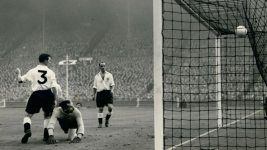r00fie1
Well-known member

Wing Commander Charles Reep: The Father Of Long Ball Football?
Former RAF officer Wg Cdr Charles Reep was one of the pioneers of collecting data on matches and an advocate of direct football.
Wing Commander Charles Reep: The Father Of Long Ball Football?

Former RAF officer Wg Cdr Charles Reep was one of the pioneers of collecting data on matches and an advocate of direct football.
Former Royal Air Force Wing Commander Charles Reep is considered by some as the first data analyst in football.
The ex-military officer has been credited as the creator of the 'long ball' football tactic, notably working with football teams Brentford, Wolves, and full-time with Sheffield Wednesday after retiring from the RAF.
Reep's early work and analytics led to many teams opting for direct football, a style of play favoured by many English teams throughout the 1970s and 1980s.
It is a style of play often vilified for being boring, due to it often bypassing the midfield area where a skill would be performed to create different types of attacking play.
What role did his military background play?
Charles Reep studied to be an accountant, after showing a natural ability for numbers while studying at Plymouth High School.He joined the RAF Accountancy Division in 1928, achieving the rank of Wing Commander before retiring from service in 1955.
The origins of his analytical interest in football can be traced to 1933 when he attended a talk given by Charles Jones, the then-captain of Arsenal men's football team, and was fascinated by the detailed description of the tactics used to create goal-scoring opportunities.
Reep, himself, described how he began to put these methods into practice with a series of teams in the RAF.
This experience, combined with the meticulous attention to detail he had learned as an accountant, was the ideal preparation to develop his future recordings and methods.
Here he is railing against ‘continental’ style football in the early 60s pic.twitter.com/2XCqz9QKZf
— Duncan Alexander (@oilysailor) January 9, 2018
His impact on the game of football
Charles Reep's simplistic methods of long ball football have been, and continue to be, criticised by many football fans and analytics enthusiasts.He pioneered football performance analysis at the ground of Swindon Town in 1950, in a game against Bristol Rovers.
At the start of the second half, Reep took a pencil and notebook out of his pocket and he invented a method of recording what happened to every possession by both teams.
His eventual conclusions, based on the data from more than 600,000 passing moves, were scorned by those within football who enjoyed a more possession-based game.
Reep was the first person to develop and apply a sports notational system in the country, continuing to challenge English football, backing his findings in the publications with his stats.
He saw how the information he was collecting could be used to plan strategy and analyse performance, and this was long before the well-known Opta-style stats.

Who used his system?
A handful of English managers, including Graham Taylor and Dave Bassett, based their style of play on Reep's findings with some great success.A similar analysis of the game was also later adapted by Egil Olsen and was a key part of Norway's international success in football during the 1990s.
Their adopted direct style of play took them to a peak of number two in the FIFA world rankings, qualifying for two major tournaments in the process – 1994 FIFA World Cup and 1998 FIFA World Cup.
In 1993, after beating England 2-0 Olsen, commenting to a Guardian reporter, said: "I still follow Charles Reep," turning to then 93-year-old Charles Reep for tactical guidance.
"I would say that the only difference is that, especially with Norway, we slightly improved his system.
"But I'm in close touch with him. Even in his 90s, he collects these statistics that show how many times a team puts the ball into 'the reacher area' – a larger attacking area around the penalty box.
"I still use these to understand a team's effectiveness," he added.
Cover image: Hungary humiliating England at Wembley in 1953 - the hosts' 6-3 defeat left an impression on Charles Reep, and reaffirmed some of his ideas on direct styles of play (Picture: Alamy).
